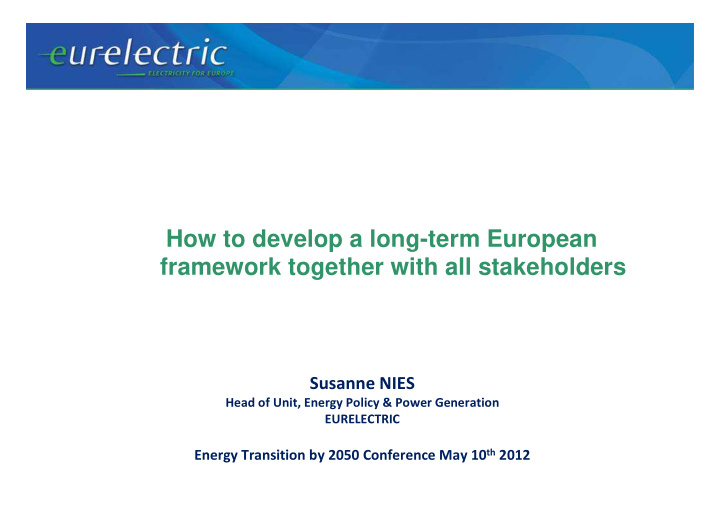



How to develop a long-term European framework together with all stakeholders Susanne NIES Head of Unit, Energy Policy & Power Generation EURELECTRIC Energy Transition by 2050 Conference May 10 th 2012
The voice of the European Electricity Industry • A truly integrated EU market • Carbon-neutrality by 2050 • Electricity is the solution • Yes to the three EU ‘no regrets’: RES, energy efficiency, infrastructure • but not necessarily sharing the suggested methodology…
EURELECTRIC is strongly committed to the 2050 decarbonisation agenda • This has been highlighted in our CEO Declaration, signed in 2009 by 61 CEO of the power industry • A clear EU decarbonisation target for 2030 is needed • ETS’ contribution should be complemented by a stronger focus on innovation and on research, development and demonstration • Overall, Europe needs consistency and a cost-efficient, market driven approach
Current Challenges • Energy transition unprecedented effort • Need for long term signals • Ageing park • Lack of coordination EU policies: eg. German nuclear phase out, RES build in, setting up of electricity security group as a consequence… • No system approach, lack of investments both in generation as in grids • No risk for generation adequacy yet, but might occur if current situation not improved… • Need for European infrastructure, storage, and smart grids = Consistent Policies on EU level are key!
Who are the stakeholders? • Government • Regulators • TSOs • Industry • The consumer
Policies: How to develop a common vision? • GOVERNMENTS -Government to set consistent framework: ETS key driver -Continue liberalisation : three packages, should be continued Integrate the European market -subsidiarity (various government levels) • INDUSTRY Industry to invest and to pick up the most cost-efficient solution towards 2050 • BOTH -Involve citizens and consumers -Risk sharing facilities (new technologies, deployment), ppp on RDD -to innovate on services and products: governments to innovate (represent 40% of GDP!)
Evolution of generation mix in the EU 2020 Scenario 5.5 % 45% 37,5% 11% Source: ENTSO-E
European integrated markets will deliver more Plethora of national support systems, lack of market integration We need to connect and deficient interconnections… surpluses to deficits! Source: DG ENER
The legislative agenda: consistency to work in!
Annual Capex – actual and required 120 100 80 n €b 60 40 20 0 1999 2000 2001 2002 2003 2004 2005 2006 2007 2008 2009 2010 2011 2012 2013 2014 2015 2016 2017 2018 2019 2020 Source: Citigroup Investment Research 10
Role and Position of the Private Sector • Electricity sector very long term!= need for stable investment climate • Lions share of investment to be taken up by the private sector • Investments have become a challenge for many reasons: CAPEX, New technologies, financial crisis and banks/utilities etc. • Need to have a favourable framework for low carbon investments • Timing matters, in order to avoid overstretch with unrealistic ambitions in high speed transition to low carbon economy • Today volatile: examples RES changes, Nuclear phase out, ETS… • Need for an incentivizing regulatory framework • Increasing concern with poorly adapted market design today, both for RES, as well as for back up, storage, transmission, smart grids
EURELECTRIC’s Key Policy Recommendations There is a need for a system approach in delivering on investments Policy makers have to set frameworks, not specific targets. The market shall deliver on the technology mix within the set framework, not governments. Use of cooperation mechanisms and progressive convergence of support schemes for RES must be incentivised. A long-term policy must build on the EU ETS as a key driver of cost-effective decarbonisation. More Europe is needed to enhance economies of scale, and to increase Europe’s attractiveness for investors.
Recommend
More recommend